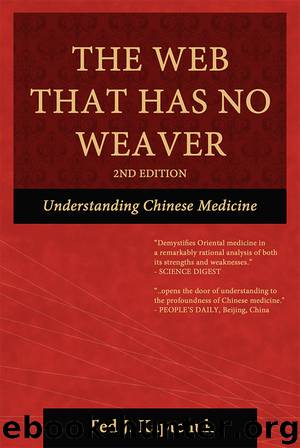The Web That Has No Weaver by Ted Kaptchuk

Author:Ted Kaptchuk
Language: eng
Format: epub
Publisher: BookBaby
Published: 2014-11-11T05:00:00+00:00
EAST AND WEST RECONSIDERED
At this point, the nature of the difference between the perceptions of Eastern medicine and biomedicine needs to be reexamined. In Chapter I it was demonstrated in a very simple way that six patients suffering from ulcer could be perceived quite differently by Chinese and Western doctors. This illustrated the fact that a single Western disease entity may become various diagnoses of medical disharmonies within the framework of East Asian medicine.
Now let us take a closer look at the actual study of the sixty-five gastric-ulcer patients from which the six patients were chosen as examples (see Chapter I, note 7). All of these patients had theoretically identical diseases in the terms of biomedicine.
About half of the sixty-five Chinese diagnoses cited various Spleen disharmonies (Deficiency, Dampness, Cold, etc.), while the rest pointed to Stomach and Liver disharmonies. None of the patients was described as having a Lung or Kidney disharmony. Thus, the diagnoses of the biomedical entity did not yield a totally random sample of Chinese medical disharmonies. From the universe of possible Chinese diagnoses, the single Western diagnosis of gastric ulcer was paralleled by a few specific clusters of disharmony patterns.
If this experiment had been reversed and a number of patients, all diagnosed by a Chinese physician as manifesting the same pattern of disharmony, had been seen by a Western physician, several distinct Western disease entities would be diagnosed. However, a high incidence of certain specific clusters of diseases would emerge. Although there are no one-to-one correspondences between Chinese and Western diagnoses, a type of correlation can indeed be found.
This correlation may be demonstrated by using the pattern of Deficient Spleen Qi as an example. This pattern is associated with such signs as chronic fatigue, lack of motivation and desire, appetite disorder, poor digestion, watery stool, abdominal distention, pale tongue material with thin, white moss, and empty pulse.
If a large group of patients with this disharmony were looked at from a Western perspective, depending on where recruitment occurred, maybe half of them would be diagnosed as having chronic gastrointestinal disorders such as gastroenteritis, ulcers, or nervous stomach. A significant number would be thought to have chronic hepatitis, hemorrhoids, amenorrhea, anemia, and various bleeding disorders. A smaller percentage would be diagnosed as having major depressive disorder, chronic fatigue disorder, and degenerative neuromuscular disorders.3 It would be unlikely that any of the patients exhibiting Deficient Spleen Qi would be discovered to have acute urinary infections, glaucoma, or pleurisy.4
Another example is the pattern of Liver Fire, the signs of which may include red face; red eyes; scanty, dark urine; constipation; severe headaches and/or ringing in the ears; anger and frequent episodes of rage; nausea or vomiting; red tongue material with yellow moss; and wiry, full, and fast pulse. In Western terms, people with this pattern might be diagnosed as having hypertension, migraine, atherosclerosis, acute conjunctivitis, glaucoma and other eye disorders, or acute hepatitis, with a smaller percentage thought to have bleeding disorders and urogenital infections.5 Some would be considered psychiatric patients.
Download
This site does not store any files on its server. We only index and link to content provided by other sites. Please contact the content providers to delete copyright contents if any and email us, we'll remove relevant links or contents immediately.
| Administration & Medicine Economics | Allied Health Professions |
| Basic Sciences | Dentistry |
| History | Medical Informatics |
| Medicine | Nursing |
| Pharmacology | Psychology |
| Research | Veterinary Medicine |
The Immortal Life of Henrietta Lacks by Rebecca Skloot(4550)
An American Plague by Jim Murphy(3734)
The Emperor of All Maladies: A Biography of Cancer by Siddhartha Mukherjee(3112)
The Gene: An Intimate History by Siddhartha Mukherjee(3074)
The Fate of Rome: Climate, Disease, and the End of an Empire (The Princeton History of the Ancient World) by Kyle Harper(3030)
Rebecca Skloot by The Immortal Life of Henrietta Lacks(1988)
Stiff - The Curious Lives of Human Cadavers by Mary Roach(1836)
The Great Influenza by John M Barry(1763)
The Vaccine Race by Meredith Wadman(1639)
Hero by Michael Grant(1620)
Undue Risk by Moreno Jonathan D.;(1609)
Three Cups of Tea by Greg Mortenson(1597)
The Mystery of the Exploding Teeth by Thomas Morris(1556)
Quackery by Lydia Kang(1533)
Autism's False Prophets by Paul A. Offit(1516)
A Journal of the Plague Year (Oxford World's Classics) by Daniel Defoe(1503)
Extremes: Life, Death and the Limits of the Human Body by Fong Kevin(1502)
Steroids: History, Science, and Issues by Standora Joan E.; Bogomolnik Alex; Slugocki Malgorzata(1499)
The Vaccine Court by Rohde Wayne(1488)
